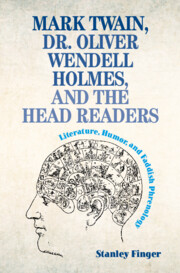 Mark Twain, Dr. Oliver Wendell Holmes, and the Head Readers
Mark Twain, Dr. Oliver Wendell Holmes, and the Head Readers Published online by Cambridge University Press: 17 April 2023
Mark Twain now began to lampoon the head readers as cheats and frauds. He first did this in The Adventures of Tom Sawyer, which appeared in 1876, and continued to do so in its sequel, Adventures of Huckleberry Finn, which appeared eight years later. He described Tom Sawyer’s Aunt Polly as a believer in “phrenological frauds” and as “an easy victim” in the first of these often-paired novels. More telling, he explained how they operated in Huckleberry Finn, using a phony duke and king bilking unsuspecting victims along the Mississippi River for this purpose. These two characters mention how they rely on gathering advance information for some of their schemes, and they brag about putting on charades. As they saw it, phrenology was an easy-entry business that anyone with a good set of eyes and ears along with some acting skills could exploit. This chapter also presents Twain’s use of phrenology in Life on the Mississippi, a book he completed in 1883 after returning to St. Louis and to relive the river between it and New Orleans.
To save this book to your Kindle, first ensure [email protected] is added to your Approved Personal Document E-mail List under your Personal Document Settings on the Manage Your Content and Devices page of your Amazon account. Then enter the ‘name’ part of your Kindle email address below. Find out more about saving to your Kindle.
Note you can select to save to either the @free.kindle.com or @kindle.com variations. ‘@free.kindle.com’ emails are free but can only be saved to your device when it is connected to wi-fi. ‘@kindle.com’ emails can be delivered even when you are not connected to wi-fi, but note that service fees apply.
Find out more about the Kindle Personal Document Service.
To save content items to your account, please confirm that you agree to abide by our usage policies. If this is the first time you use this feature, you will be asked to authorise Cambridge Core to connect with your account. Find out more about saving content to Dropbox.
To save content items to your account, please confirm that you agree to abide by our usage policies. If this is the first time you use this feature, you will be asked to authorise Cambridge Core to connect with your account. Find out more about saving content to Google Drive.